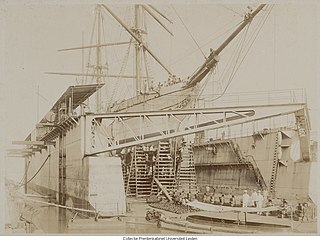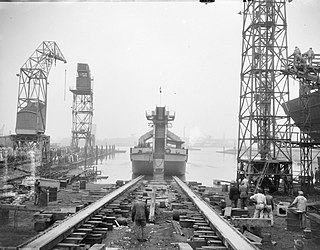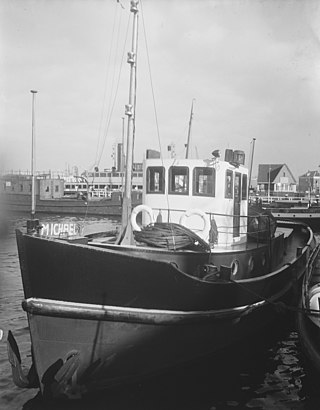
The Rotterdamsche Droogdok Maatschappij (RDM) was the largest pre-World War II shipbuilding and repair company in Rotterdam in the Netherlands, existing from 1902 to 1996. It built 355 mostly major seagoing vessels, 18 of which were submarines. During its existence, the wharf operated 12 floating docks and in its heyday employed 7,000 people at one time.

Pieter Corneliszoon Hooft was a Dutch ocean liner built in 1925. An onboard fire destroyed her passenger accommodation before she was completed. In 1932, another fire damaged her so severely that she was sold for scrapping, only to catch fire again before she was scrapped.

The Groningen class was a class of steam corvettes of the Royal Netherlands Navy. The class comprised Groningen, Citadel van Antwerpen and Vice-Admiraal Koopman

Van Vlissingen en Dudok van Heel was a famous nineteenth-century Dutch machine factory. It built steam engines and machinery for the sugar industry and for maritime purposes, as well ships, rolling stock and large metal structures like the Moerdijk bridge and a floating dock. In 1871 it was reorganized to become the public company Koninklijke Fabriek van Stoom- en andere Werktuigen. In a second reorganization in 1890, parts of it were saved and continued under the name Koninklijke Nederlandsche Fabriek van Werktuigen en Spoorwegmaterieel, renamed to Werkspoor in 1927.

The Samarang class was a class of steam screw gunvessels of the Royal Netherlands Navy. The class originally comprised Samarang, Batavia and Makassar, but was later extended.

Wilton's Dok- en Werf Maatschappij was a Dutch shipbuilding company active as an independent company from 1854 till 1929. At first it was simply known as 'Wilton'. In 1921 the final Dutch name became: 'Wilton's Dok- en Werf Maatschappij NV', the equivalent of 'Wilton Engineering and Slipway Company'. Wilton started as a traditional smithy and expanded in machinery. It specialized in ship repairs, but also became a shipyard. At first only for fresh water ships. In spite of multiple name changes the company was commonly referred to as 'Wilton'. In 1929 a merger with Fijenoord led to a new company known as Wilton-Fijenoord.

Fijenoord was a shipbuilding company and machine factory in Rotterdam the Netherlands from 1823 to 1929. In 1929 it merged with Wilton to become Wilton-Fijenoord.

The Haarlemmermeer class was a class of nine gunvessels of the Royal Netherlands Navy. The class was a failure because of its extreme susceptibility to dry rot.

The Nederlandsche Scheepsbouw Maatschappij, was a Dutch shipbuilding company based in Amsterdam. It existed from 1894 to 1946. From c. 1908 it was the biggest Dutch shipbuilding company.

Tanjung Priok Dock of 4,000 Tons, was a floating dry dock built for Droogdok-Maatschappij Tandjong Priok in the 1890s.

Tanjung Priok Dock of 8,000 tons was a floating dry dock built for Droogdok-Maatschappij Tandjong Priok in the 1920s.

Surabaya Dock of 3,500 tons was a floating dry dock which served in Indonesia from about 1913 till about 1956.

J. & K. Smit was a Dutch shipbuilding company located in Kinderdijk and Krimpen aan de Lek. Its successor is now part of Royal IHC.

L. Smit en Zoon previously known as Fop Smit, was a Dutch shipbuilding company located in Kinderdijk. Its successor is now part of Royal IHC.

The Nederlandsche Stoomboot Maatschappij ( ), abbreviated as NSM or NSBM, was a Dutch shipping line focused on inland navigation. In the 1820s it was important for the quick introduction of steam power on the Dutch rivers and on the Rhine. NSM owned the major shipbuilding company Fijenoord.

Hercules was a Dutch steam paddle tugboat. She was also the first vessel to effectively use a compound steam engine. In about 1890, a discussion about the invention of the compound steam engine made that Fijenoord brought up the blueprints of Hercules. These proved that Gerhard Moritz Roentgen had invented the compound steam engine.

HNLMS Orkaan (A837) was a tugboat of the Royal Netherlands Navy (RNN). She served in the RNN between 1949 and 1961. It was at the time the largest tugboat to be built in the Netherlands for the RNN.

SS Benbrack was a 19th-century British merchant steamship, built before 1883.
SS Vidar was a 1873-built, 60-metre -long Swedish steamship. It was owned by shipping company Ang Fartyg and was registered in Gothenburg. On 20 September 1875 the ship was driven ashore and wrecked on Terschelling, the Netherlands. The crew members were rescued.
SS Thasos, originally named Theben, was an 1878-built 82-metre (269 ft) German cargo steamship. It was owned by the Kosmos Line sailing for years to South America. In 1895 the ship was acquired by the Deutsche Levante-Linie and scheduled for a regular connection to countries around the Black Sea.



















